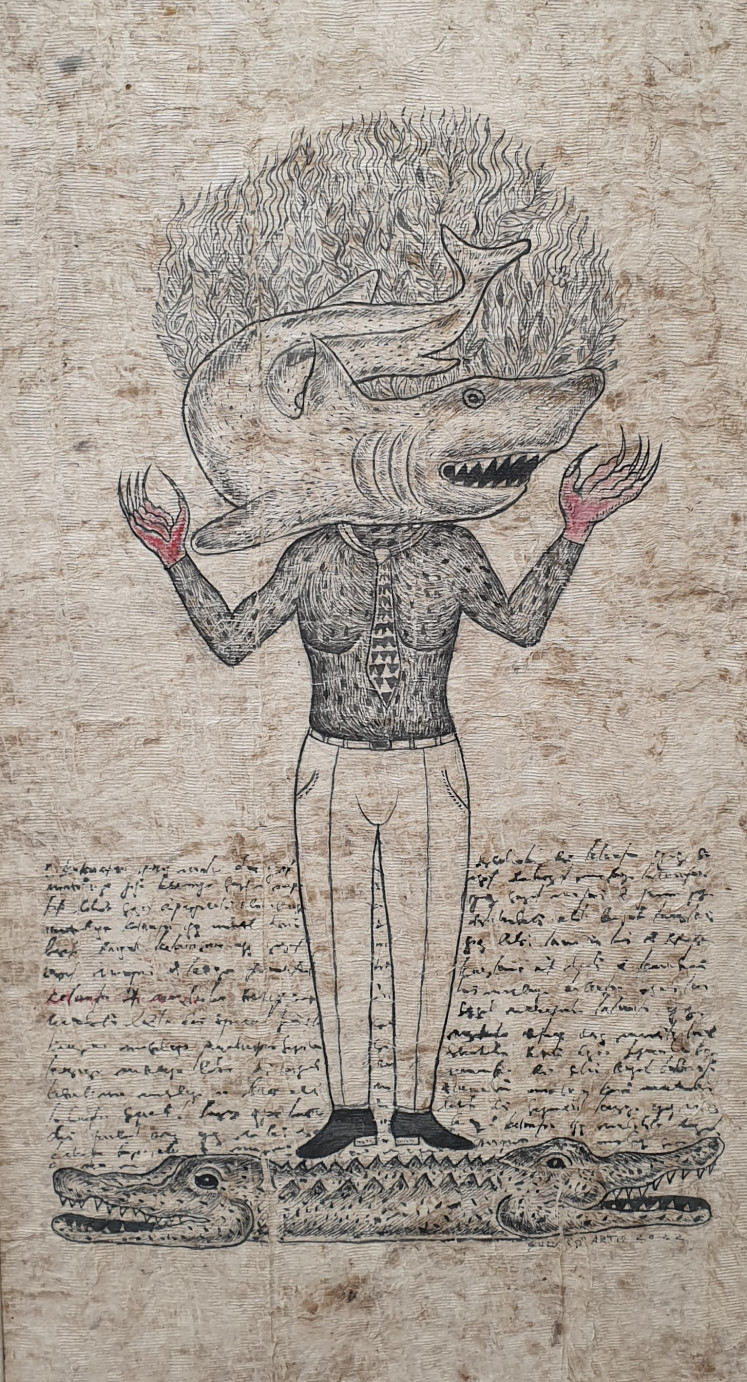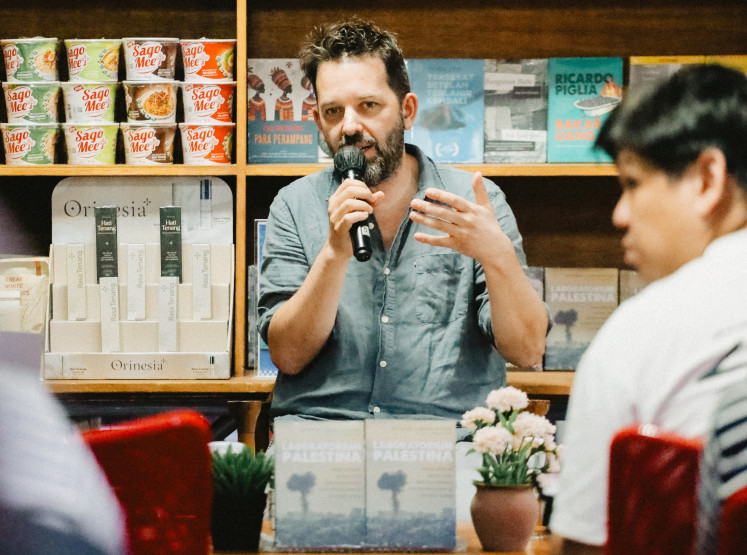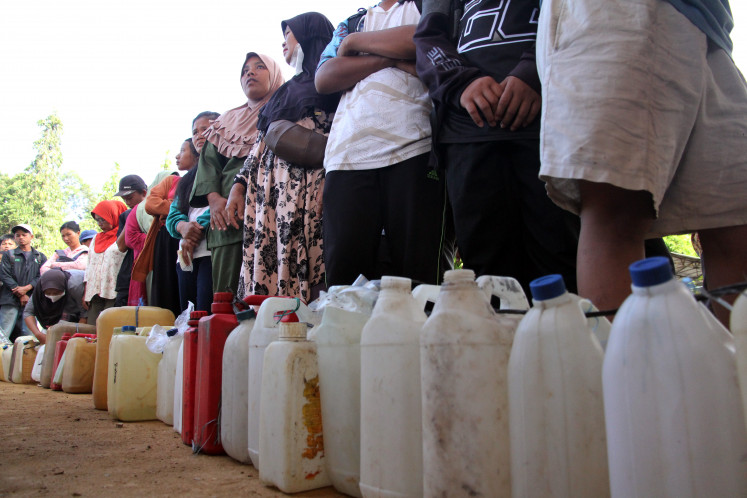Popular Reads
Top Results
Can't find what you're looking for?
View all search resultsPopular Reads
Top Results
Can't find what you're looking for?
View all search resultsWarna Bali: Landmark exhibit traces Balinese color philosophy
Change text size
Gift Premium Articles
to Anyone
 Color immersion: Visitors view the artwork on display during the exhibition opening on Oct. 15, 2022 for Warna Bali: Natural Balinese Colors in The Contemporary Arts at the Gala Rupa Balinesia Art Space in Kuta, Bali. The exhibition of artwork, which were made using all-natural mediums, is the culmination of research into the Balinese color philosophy and traditional techniques. (Courtesy of Gurat Art Project) (Courtesy of Gurat Art Project)
Color immersion: Visitors view the artwork on display during the exhibition opening on Oct. 15, 2022 for Warna Bali: Natural Balinese Colors in The Contemporary Arts at the Gala Rupa Balinesia Art Space in Kuta, Bali. The exhibition of artwork, which were made using all-natural mediums, is the culmination of research into the Balinese color philosophy and traditional techniques. (Courtesy of Gurat Art Project) (Courtesy of Gurat Art Project)
W
arna Bali is a landmark exhibit that takes visitors on a visual experience of traditional Balinese color philosophy through contemporary art.
Color intricately unifies the magnitude of Balinese culture. Superb and charismatic, color defines the visual experience. Sacred traditional knowledge confirms color as an essential element of the artistic, esthetic and symbolic culture that is rich in philosophical import.
These vital interrelationships are mapped precisely in the Balinese Nawasanga, or color mandala. Cultural intelligence, from the physical to the nonphysical realms, is linked in this natural and universal system.
Warna Bali: Natural Balinese Colors in The Contemporary Arts, a landmark group exhibit and cultural highlight of 2022, opened on Oct. 15 at Gala Rupa Balinesia Art Space in Kuta. The exhibition, which runs until Nov. 15, has two components: the results of Balinese color research and the creations of 13 contemporary Balinese artists focusing on Balinese color development.
The exhibit also marks the establishment of a new arts foundation in the province, Yayasan Gala Rupa Balinesia, which aims to establish a center for new Balinese art in Ubud.
The featured artists are Chusin Setiadikara, Dewa Gede Ratayoga, Djaja Tjandra Kirana, I Ketut Suwidiarta, I Made Griyawan, I Nyoman Rediasa, I Made Wiradana, I Wayan Redika, I Wayan Suja, I Wayan Sujana, Ni Nyoman Sani, Nyoman Erawan and Osbert Lyman.
“Color as an artistic medium is historically rooted in the traditional practice of visual culture based on Balinese religiosity,” curators I Wayan Seriyoga Parta and I Made Susanta Dwitayana write in the exhibition catalog.
“Until now, the technical and knowledge systems of color have remained limited to certain sangging”, they say, referring to traditional collectives with royal patronage responsible for creating all sacred ritual artifacts and objects, including masks for theatrical performances, wayang puppets and classical paintings.
“There has never been an attempt to formulate this cultural capital into a science that includes media and philosophical concepts.”
In June 2021, Gurat Institute, the Gurat Indonesia Cultural Community’s research division, began collaborating with the Gala Rupa Balinesia Foundation on researching and documenting the most up-to-date and comprehensive knowledge base on Balinese color. The research findings were then cross-examined against existing records and literature to become the basis of an initiative from the Gurat Art Project, Gurat Indonesia’s division that focuses on art curation, events and programs, as well as producing works of art.
Balinese color has its own technical aspects and characteristics, as it is made from natural materials, so the resulting visual effects are very different from synthetic colors.
Traditional papermaking: Warna Bali: Natural Balinese Colors in The Contemporary Arts, which runs until Nov. 15, 2022, also features the process of producing kertas ulantaga, a natural paper made from the paper mulberry by Aryatama Nugraha. (JP/Richard Horstman) (JP/Richard Horstman)The participating artists used current practices that were unrelated to Bali’s traditional techniques and knowledge system, and were challenged to create art on a medium made from ulantaga or daluang, the paper mulberry tree, using traditional techniques. Kertas ulantaga (mulberry paper) has different absorption properties compared to modern paper, so it presented technical challenges.
Five natural color bases were used: pork bone powder for white, soot or mangosteen rind for black, gincu (cinnabar) for red, batu pere (limestone) for yellow and tarum (broad-leafed indigo) leaves for blue. These bases produce colors with distinctive characteristics that are used in traditional sacred works, such as wayang kulit (leather puppets), theatrical masks and Kamasan-style paintings.
The exhibit’s inclusion of I Made Griyawan, one of the leading contemporary pioneers of traditional Batuan-style paintings, is significant. While the artist had to modify his method of applying color, the textural quality of the mulberry paper enhanced his artistic style.
Lingga Yoni resonates deep visual tones reminiscent of the original Batuan paintings of the 1920s, when their themes emphasized duality and the light and dark aspects of the human experience.
“This experience led me to a deeper understanding of the Balinese color philosophy,” Griyawan told The Jakarta Post.
Spiritual symbols: ‘Rajah’ (2022) by I Ketut Suwidiarta, natural Balinese color on mulberry paper, 75 cm x 41.5 cm (JP/Richard Horstman) (JP/Richard Horstman)“I responded to the paper’s color, texture and antiquity with a monochromatic figurative drawing with a refined use of red,” said I Ketut Suwidiarta of his composition Rajah. The term rajah refers to the Balinese script associated with mystical objects and spiritual art. Suwidiarta invents his own expressive symbolic language and excels in this work.
Senior artist Chusin Setiadikara is noted for his realism paintings of the highest technical standards. Pose juxtaposes the power of the subtle figurative lines of a partly naked woman against a background of pulsating movement. Modified classical Balinese rock icons are married with dynamic gray, light blue and red abstract brush strokes highlighted by the paper’s sensuous fibers. The composition is anchored in the lower section by a span of black that functions as the subject’s seating. The visual composition cannot be faulted, and the work contrasts elegance, chaos and motion alongside stillness.
Meanwhile, Nyoman Erawan’s abstract expression Suklapaksa captures a refined and reserved example of his creative power, but Kresnapaksa is distinguished by the artist crumpling the paper and presenting its esthetically attractive valleys and peaks as a three-dimensional artwork.
“I describe the expressive sensations of working with the natural materials as an inner conversation between the paper, brushes, color and myself as an artist,” renowned artist I Wayan “Suklu” Sujana, who is also a lecturer at the Indonesian Arts Institute (ISI), told the Post.
“I experienced déjà vu, feeling what the undagi [traditional master architect], sangging and citakara [sacred painting specialist] did in the past, creating works for communal presentation,” he added.
The natural materials also presented a technical problem to solve.
“Initially, I studied and sensed the properties and characteristics of the colors, their density and transparency,” said I Wayan Redika, a master of extraordinarily detailed and precise compositions. “However, achieving strong color coverage was difficult, due to the paper’s absorption quality. Finally, from several failures, I found an appropriate method for my style.”
Redika’s Heritage reveals that he was able to achieve his usual excellent standards.
“The nature of the Balinese color, especially white from the bones, was the solution, making it easier for me to work. White can mix with other colors to form a shiny new color with the density I desire,” he observed.
The Warna Bali initiative pushed the artists into new technical and creative territory, and the outcomes represent a historical breakthrough in Balinese contemporary art. Furthermore, it represents the beginning of a new momentum in reinvigorating traditional color practices and knowledge in the creation and discourse of Balinese contemporary art.
Two significant aspects anchor the exhibition. A small room displays sacred communal artwork that are historically linked and animated by Balinese colors: masks, wayang puppets and a classical painting. Also presented are two 30-minute documentary films, the first documenting the research and data on the use of Balinese colors in traditional artwork, complimented by reviews and opinions from the Gurat Institute team. The other features testimonies from the curators and participating artists on the art project.
Another room focuses on displays featuring the raw materials used to make the pigments and mulberry paper, with supporting information and photographs. Samples of 31 different natural colors created using local knowhow and four pieces of the beautiful handmade paper are also on display. Special praise must be given to Aryatama Nugraha, who created the traditional paper.
Excellent display lighting enhances the works’ sensual attributes. The natural pigments in the paint and paper, as well as the paper’s fibers, vibrate with a noticeable life force. The building’s ample vertical space offers perfect viewing potential, and the gallery’s design features heighten the feel-good qualities and therefore, overall appreciation.
Warna Bali: Natural Balinese Colors in The Contemporary Arts is distinguished by its glowing atmosphere, a unique experience beyond what is visible. Beautiful visual and nonvisual sensations invigorate visitors upon entering the gallery. The spirit of human creativity imparted within the natural materials of the artwork manifests in a heartwarming ambience that cannot be achieved by modern synthetic materials.












